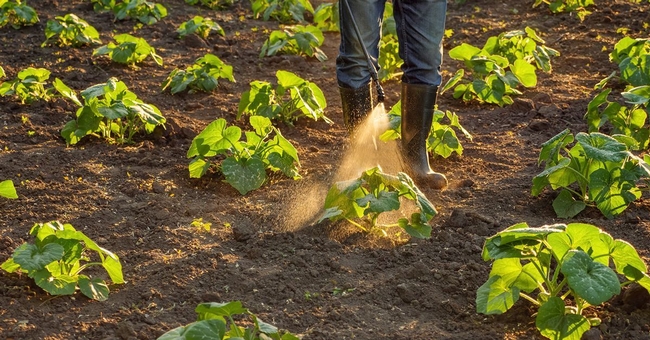Nanoparticles made from plant viruses
could be farmers' new ally in pest control
University of California - San Diego – Press Release
A new form of agricultural pest control could one day take root—one that treats crop infestations deep under the ground in a targeted manner with less pesticide.
Engineers at the University of California San Diego have developed nanoparticles, fashioned from plant viruses, that can deliver pesticide molecules to soil depths that were previously unreachable. This advance could potentially help farmers effectively combat parasitic nematodes that plague the root zones of crops, all while minimizing costs, pesticide use and environmental toxicity.
Controlling infestations caused by root-damaging nematodes has long been a challenge in agriculture. One reason is that the types of pesticides used against nematodes tend to cling to the top layers of soil, making it tough to reach the root level where nematodes wreak havoc. As a result, farmers often resort to applying excessive amounts of pesticide, as well as water to wash pesticides down to the root zone. This can lead to contamination of soil and groundwater.
To find a more sustainable and effective solution, a team led by Nicole Steinmetz, a professor of nanoengineering at the UC San Diego Jacobs School of Engineering and founding director of the Center for Nano-ImmunoEngineering, developed plant virus nanoparticles that can transport pesticide molecules deep into the soil, precisely where they are needed. The work is detailed in a paper published in Nano Letters.
Steinmetz's team drew inspiration from nanomedicine, where nanoparticles are being created for targeted drug delivery, and adapted this concept to agriculture. This idea of repurposing and redesigning biological materials for different applications is also a focus area of the UC San Diego Materials Research Science and Engineering Center (MRSEC), of which Steinmetz is a co-lead.
“We're developing a precision farming approach where we're creating nanoparticles for targeted pesticide delivery,” said Steinmetz, who is the study's senior author. “This technology holds the promise of enhancing treatment effectiveness in the field without the need to increase pesticide dosage.”
The star of this approach is the tobacco mild green mosaic virus, a plant virus that has the ability to move through soil with ease. Researchers modified these virus nanoparticles, rendering them noninfectious to crops by removing their RNA. They then mixed these nanoparticles with pesticide solutions in water and heated them, creating spherical virus-like nanoparticles packed with pesticides through a simple one-pot synthesis.
This one-pot synthesis offers several advantages. First, it is cost-effective, with just a few steps and a straightforward purification process. The result is a more scalable method, paving the way toward a more affordable product for farmers, noted Steinmetz. Second, by simply packaging the pesticide inside the nanoparticles, rather than chemically binding it to the surface, this method preserves the original chemical structure of the pesticide.
“If we had used a traditional synthetic method where we link the pesticide molecules to the nanoparticles, we would have essentially created a new compound, which will need to go through a whole new registration and regulatory approval process,” said study first author Adam Caparco, a postdoctoral researcher in Steinmetz's lab. “But since we're just encapsulating the pesticide within the nanoparticles, we're not changing the active ingredient, so we won't need to get new approval for it. That could help expedite the translation of this technology to the market.”
Moreover, the tobacco mild green mosaic virus is already approved by the Environmental Protection Agency (EPA) for use as an herbicide to control an invasive plant called the tropical soda apple. This existing approval could further streamline the path from lab to market.
The researchers conducted experiments in the lab to demonstrate the efficacy of their pesticide-packed nanoparticles. The nanoparticles were watered through columns of soil and successfully transported the pesticides to depths of at least 10 centimeters. The solutions were collected from the bottom of the soil columns and were found to contain the pesticide-packed nanoparticles. When the researchers treated nematodes with these solutions, they eliminated at least half of the population in a petri dish.
While the researchers have not yet tested the nanoparticles on nematodes lurking beneath the soil, they note that this study marks a significant step forward.
“Our technology enables pesticides meant to combat nematodes to be used in the soil,” said Caparco. “These pesticides alone cannot penetrate the soil. But with our nanoparticles, they now have soil mobility, can reach the root level, and potentially kill the nematodes.”
Future research will involve testing the nanoparticles on actual infested plants to assess their effectiveness in real-world agricultural scenarios. Steinmetz's lab will perform these follow-up studies in collaboration with the U.S. Horticultural Research Laboratory. Her team has also established plans for an industry partnership aimed at advancing the nanoparticles into a commercial product.
Paper title: “Delivery of Nematicides Using TMGMV-Derived Spherical Nanoparticles.” Co-authors include Ivonne Gonzalez-Gamboa, Samuel S. Hays and Jonathan K. Pokorski, UC San Diego.
This work was supported in part by the U.S. Department of Agriculture (grants NIFA-2020-67021-31255 and NIFA-2022-67012-36698), the National Science Foundation (CMMI 1901713) and the UC San Diego Materials Research Science and Engineering Center (MRSEC), which is supported by the National Science Foundation (grant DMR-2011924). This work was performed in part at the San Diego Nanotechnology Infrastructure (SDNI) at UC San Diego, a member of the National Nanotechnology Coordinated Infrastructure, which is supported by the National Science Foundation (grant ECCS-1542148). This work was also performed in part at the UC San Diego Department of Neurosciences Microscopy Core, which is supported by the National Institutes of Health (NINDS P30NS047101).
DOI 10.1021/acs.nanolett.3c01684
Liezel Labios
University of California - San Diego
llabios@ucsd.edu
Office: 858-246-1124
